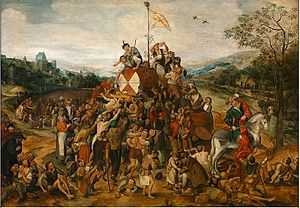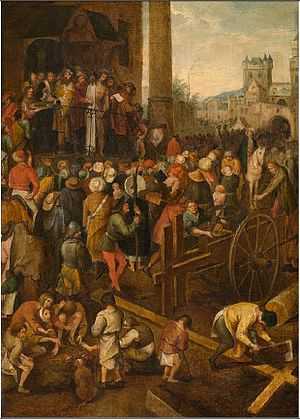Pieter Balten

Pieter Balten, Pieter Baltens or Pieter Custodis (c. 1527 in Antwerp – 1584 in Antwerp), was a Flemish Renaissance painter, draughtsman and engraver of religious works, village scenes and landscapes who was closely associated with Pieter Brueghel the Elder.
Life
Details on his life are scarce. Balten was born in Antwerp c. 1527 as the son of Balten Custodis (or Balten Janszoon de Costere). He became a member of the local Guild of Saint Luke in 1540 and became a master in 1550.[1][2] The early 17th-century art historian Karel van Mander stated in his 1604 Schilder-boeck that Balten became a member of the Guild of St. Luke in 1559 and was a follower of Pieter Brueghel the Elder. Van Mander further wrote that Balten was a good poet and rederijker and collaborated from time to time with the painter Cornelis Ketel.[3]
It is now known that Van Mander was wrong on the date on which Balten joined the local Guild as well as on Balten’s relationship with Pieter Brueghel the Elder which he qualified as that of a follower.[1] In 1550-1551 Brueghel in fact worked as an assistant of Pieter Balten. Balten is known to have collaborated with Brueghel and may even have influenced him.[1][2]
His son Dominicus married the widow of Bartholomäus Kilian and set up an engraving workshop in Augsburg, known as the Kilian family of engravers.[4]
Work

Balten painted religious works, village scenes and landscapes. Not many of his works have been preserved. His most famous composition is the St Martin’s Day Kermis of which there are two versions (Rijksmuseum and Royal Museum of Fine Arts Antwerp). This work was previously believed to have been a copy after a lost work by Pieter Brueghel the Elder, but it is now considered equally likely that it was Balten’s own creation. Breughel and Balten further collaborated on an altarpiece for Mechelen. Pieter Bruegel the Younger copied a detail of his work Ecce homo as an independent work.[2]
Van Mander praised Balten as a landscape painter. Originally no known independent landscapes by Balten were known until the attribution to him of six landscape drawings. He was further active as an engraver and publisher. His engravings are copies of his own work and that of other artists of his time such as Marten de Vos and Ambrosius Francken I. He made a series of engravings of the counts and countesses of Flanders as well as popular subjects such as village scenes and allegories.[2]
References
- ↑ 1.0 1.1 1.2 Pieter Balten at the Netherlands Institute for Art History (Dutch)
- ↑ 2.0 2.1 2.2 2.3 Jan Van der Stock. "Baltens, Peeter." Grove Art Online. Oxford Art Online. Oxford University Press. Web. 30 July 2014
- ↑ Pieter Balten in: Karel van Mander, Schilder-boeck, 1604 (Dutch)
- ↑ Dominicus Custos at the Netherlands Institute for Art History (Dutch)
External links
-
 Media related to Pieter Balten at Wikimedia Commons
Media related to Pieter Balten at Wikimedia Commons - Pieter Bruegel the Elder: Drawings and Prints, a full text exhibition catalog from The Metropolitan Museum of Art, which includes material on Pieter Balten (see index)
- Pieter Balten on Artnet